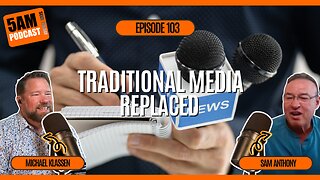Premium Only Content

History of Deadliest Prison and Street Gangs United States and Your Gun Right Laws
No matter how strict you make gun laws a criminal will always be a criminal and a criminal with a gun or without a gun, will always break the law. I don’t believe the lies they are trying to feed you they don’t work. In this video, we're going to take a look at the history of gangs and the deadliest street gangs in the world. We'll explore the role gangs have played in different parts of history, and we'll look at some of the most notorious prison gangs in the world.
Radical culture change instigated by conflict among diverse cultural groups has had adverse social and psychological effects witnessed by the rise of youth gangs. A close look at the processes of gang formation in Chicago, Los Angeles, and New York City illustrates that rapid changes in core cultural systems had a chilling effect on ethnic groups’ core cultural practices, such as adolescents’ rites of passage to adulthood. In the absence of culturally prescribed, ritual activities, adolescents have not been prepared to assume their culture’s prescribed adult roles. That radical loss in a core cultural tradition has adversely affected adolescents’ behavior. Research in the early decades of the 20th century in Chicago reported that adolescent gang members experienced depression, anxiety, personality disorders, and addictions as consequents of violence clashes between Chicago’s native white population and European immigrants and black migrants. Over the decades of gang research in America and Europe, sociologists and anthropologists have come to agree on cultural elements in theories of gang formation: American and European youth gangs are derivative of cultural clashes, which engender racism and fundamental antagonistic changes in cultural systems’ economic production and social control. Effects of hostile culture change include social discord, unemployment, gang, and violence.
Social network research on adolescent gangs has shown that gangs are not closed social groups limiting gang members’ interpersonal contact to co-group members. Gang and non-group adolescents differ in attributes (sex, age, education), but structural measures of adolescent gang groups and non-groups are similar. Network research has carefully examined gang and non-gang adolescents’ personal networks. A personal network of male and female gang members includes people they know who know them. A personal network’s composition can include a few friends, close friends, and best friends, and numerous others inside a gang group as well as members of other gangs and non-gang members. Personal network relations connect gang adolescents to their families, friends, and neighborhoods, despite gang membership. Gang ethnography describing youth gang members and their families has shown that gang youth have been victims of domestic and intimate partner violence, experience periods of episodic homelessness away their natal and extended kin, as well as fictive families, and suffer adverse mental health consequences.
If you're interested in learning more about the history of gangs and the deadliest street gangs in the world, then this is the video for you! By the end of this video, you'll have a better understanding of the role gangs have played in history, and you'll be able to spot the signs of a gang brotherhood or a prison gangster!
This bulletin examines the emergence and growth of gang activity in the Northeast, Midwest, West, and South regions of the United States. This report looks at the history of street gangs in the United States. The report presents information on gang activity based on the four major census areas in the United States: the Northeast, the Midwest, the West, and the South. The history of the emergence and growth of gangs is presented separately for each region. The review found that there were important differences in the history of gang emergence in these four areas. In the Northeast and Midwest, the earliest gangs arose along with the growth of immigrants from Europe, primarily white ethnic groups. In the West, gang members were of Mexican descent. In the Northeast and Midwest regions, street gangs began among adult-dominated groups engaged in criminal activities, whereas in the West, street gangs emerged from aggressive groups of young Mexican men. The review also found that each of the regions also saw a distinct second wave of Black gang development that resulted from a shift of the Black population from the South to the North and the West. In addition, gang culture in the West has continued to be reinforced by wave after wave of immigrants from Central America and Mexico.
Second Amendment Is Not Gun Control: Second Amendment Doesn’t Give Americans The “Right to bear Arms” It Prohibits the Government from ‘Disarming The People’. The Second Amendment doesn’t give Americans the “Right to bear Arms.” The 2nd Amendment” is supposed to “Prohibit the Government” from taking our Arms and ‘Disarming The People’.
It’s a protection from a possible Tyrannical Government!
There are two versions of the text of the Second Amendment, each with slight capitalization and punctuation differences, found in the official documents surrounding the adoption of the Bill of Rights. One version was passed by the Congress, while another is found in the copies distributed to the States and then ratified by them. As passed by the Congress: A well regulated Militia, being necessary to the security of a free State, the right of the people to keep and bear Arms, shall not be infringed. As ratified by the States and authenticated by Thomas Jefferson, Secretary of State: A well regulated militia being necessary to the security of a free state, the right of the people to keep and bear arms shall not be infringed.
U.S. Supreme Court: District of Columbia v. Heller (2008), “Right to bear Arms” is “clearly an individual right, having nothing whatsoever to do with service in the militia” and that it is a “Right” not to be disarmed by the Government and was not the granting of a new ‘right to have arms’.
“The Second Amendment is not about duck hunting….It is about our rights, all of our rights to be able to protect ourselves from ‘All Enemies Foreign and Domestic’. This includes protections from a possible Tyrannical Government.”
State Militia’s are completely separate from the Citizen’s Inherent Right ‘to bear Arms’.
The “Right to bear Arms” is not a State Issue, it’s a Federal Issue. No State Law can override the Federal United States Constitution.
The Preamble to The Bill of Rights Congress of the United States.
Amendment of the Constitution of the United States of America, proposed by Congress, and ratified by the Legislatures of the several States, pursuant to the fifth Article of the original Constitution.
Note: The following text is a transcription of the first ten amendments to the Constitution in their original form. These amendments were ratified December 15, 1791, and form what is known as the “Bill of Rights.”
– Amendment I
Congress shall make no law respecting an establishment of religion, or prohibiting the free exercise thereof; or abridging the freedom of speech, or of the press; or the right of the people peaceably to assemble, and to petition the Government for a redress of grievances.
– Amendment II
A well regulated Militia, being necessary to the security of a free State, the right of the people to keep and bear Arms, shall not be infringed.
– Amendment III
No Soldier shall, in time of peace be quartered in any house, without the consent of the Owner, nor in time of war, but in a manner to be prescribed by law.
– Amendment IV
The right of the people to be secure in their persons, houses, papers, and effects, against unreasonable searches and seizures, shall not be violated, and no Warrants shall issue, but upon probable cause, supported by Oath or affirmation, and particularly describing the place to be searched, and the persons or things to be seized.
– Amendment V
No person shall be held to answer for a capital, or otherwise infamous crime, unless on a presentment or indictment of a Grand Jury, except in cases arising in the land or naval forces, or in the Militia, when in actual service in time of War or public danger; nor shall any person be subject for the same offence to be twice put in jeopardy of life or limb; nor shall be compelled in any criminal case to be a witness against himself, nor be deprived of life, liberty, or property, without due process of law; nor shall private property be taken for public use, without just compensation.
– Amendment VI
In all criminal prosecutions, the accused shall enjoy the right to a speedy and public trial, by an impartial jury of the State and district wherein the crime shall have been committed, which district shall have been previously ascertained by law, and to be informed of the nature and cause of the accusation; to be confronted with the witnesses against him; to have compulsory process for obtaining witnesses in his favor, and to have the Assistance of Counsel for his defence.
– Amendment VII
In Suits at common law, where the value in controversy shall exceed twenty dollars, the right of trial by jury shall be preserved, and no fact tried by a jury, shall be otherwise re-examined in any Court of the United States, than according to the rules of the common law.
– Amendment VIII
Excessive bail shall not be required, nor excessive fines imposed, nor cruel and unusual punishments inflicted.
– Amendment IX
The enumeration in the Constitution, of certain rights, shall not be construed to deny or disparage others retained by the people.
– Amendment X
The powers not delegated to the United States by the Constitution, nor prohibited by it to the States, are reserved to the States respectively, or to the people.
AMENDMENT XVI
Passed by Congress July 2, 1909. Ratified February 3, 1913.
Note: Article I, section 9, of the Constitution was modified by amendment 16.
The Congress shall have power to lay and collect taxes on incomes, from whatever source derived, without apportionment among the several States, and without regard to any census or enumeration.
The Government does this Gun Control bit every year since 2009. And every year at least 10 million new guns are added to the 350 million we already have.
At the N.W.O. we don’t get it.
A well regulated Militia, being necessary to the security of a free State, the right of the people to keep and bear Arms, shall not be infringed.
The first semi-automatic rifle was introduced in 1885, the first semi-automatic pistol in 1892, and the first semi-automatic shotgun in 1902. Semi-automatics account for about 20 percent of the 300 million privately-owned firearms in the United States and the percentage is quickly rising, because semi-automatics now account for about 50 percent of all new firearms bought annually.
A semi-automatic rifle or semi-automatic pistol is an autoloading rifle or semi-automatic pistol that fires a single cartridge with each pull of the trigger, and uses part of the fired cartridge's energy to eject the case and load another cartridge into the chamber. For comparison, a single shot, derringer pistol and a bolt-action rifle requires the user to cycle the bolt manually before they can fire a second time, and a fully automatic rifle or pistol fires continuously until the trigger is released. This is called a Fully Automatic Sub Machine Guns.
What’s the Difference ? Machine Gun vs. Submachine Gun... Submachine guns use handgun ammunition. Machine guns use rifle ammunition. If a gun-toting character pulls the trigger and holds it there while the business end goes bang-bang-bang, then there's an excellent chance that firearm is a submachine gun or a machine gun.
So AR-15 and AK-47 Etc. Are Not Assault Weapon At ALL... Yes I Repeat Are Not Assault Weapon... So AR-15 and AK-47 & Other Guns Are and Fire Semi-Automatic Only The Same For 140 Years!
Here’s a quick cheat sheet to avoid some easy pitfalls with this terminology.
AR-15: Nope, the AR-15 isn’t a submachine gun or a machine gun. It’s not even an assault rifle. Read more about AR-15s here.
Assault Rifle: Many, but not all, machine guns (not submachine guns) are assault rifles. If it meets the criteria in this post, then you’re good to go.
Assault Weapon: Don’t use this term. At best, it’s vague. At worst, it introduces something politically loaded for no good reason. Read up on assault weapons in this post.
Fully Automatic Pistol/Fully Automatic Handgun/Fully Automatic Rifle: Even though they’re technically correct, I’ve not heard of “fully automatic pistol” or “fully automatic handgun” being used all that often. “Submachine gun” or “machine pistol” are the better bets. “Fully automatic rifle,” on the other hand, is a solid substitute for “machine gun.”
Machine Rifle: It’s tempting to use this term given machine guns use rifle ammunition, but writing in a “machine rifle” will probably win you a doofus award. Don’t be a doofus. Just write “machine gun.”
Referring to a “Submachine Gun” as a “Machine Gun” Upon Second Reference: I think this works. If a character is using a submachine gun on the first reference, and you call it a “machine gun” on the second reference as an abbreviated form, that’s kosher. Just don’t call it a corn dog. It’s not a corn dog.
Sub-Machine Gun vs. Submachine Gun: Pick one style and stick with it. I think “sub-machine gun” looks funky, and not in the good way like when I dance at wedding receptions. “Submachine gun” is the better of the two.
Submachine Pistol: Even though they fire handgun ammunition, substituting in “submachine pistol” for “submachine gun” is just too weird for this planet (and your fiction). However, “machine pistol” is a thing, and is covered a little later in this post.
Tactical Rifle: A good, but probably not great, catch-all for any military-esque, shouldered firearm. If you’re going for a generic depiction, pick submachine gun or machine gun and stick to it.
Synonym for Gun A weapon is anything that is designed to, or is used to, cause damage to a person or animal. Gun is a category of weapons that have barrels and accelerate a projectile of some kind with an explosive. Also called firearms. Some weapons with similar forms are also called guns even though they do not use an explosive or a projectile.
Yes Tyrannical Government Gun Control Is The U.S.A. Now ? See and Read About Operation Fast and Furious, the largest gunwalking probe, the ATF monitored the sale of about 122,000+ firearms sold, of which only 710 were recovered as of February 2012. A number of straw purchasers have been arrested and indicted; however, as of October 2022 over 10,000 people dead so far none of the targeted and killed. Yes Right Now Our Tyrannical Government U.S.A. Is Sell Guns To Gangs Right Now. Red Flags Laws and U.S. Gangs... Back Ground Check's - Ha ha ha Really... You Are Being Funny Now, See Video (Fast & Furious) How it went down.
The Real Number Now Are Over 1 Million Guns Sold with Out Any Back Ground Check Now as Dec. 31 2022 by the Bureau of Alcohol, Tobacco, Firearms and Explosives- Sold To The Drugs Cartels - any criminal organization with the intention of supplying Sex Worker and drug trafficking and guns etc. operations and also Remember The Taliban takes control of Afghanistan - there is a big concern emerging. $85 billion worth of military guns and equipment left by the Americans is now under Taliban's control. As of Dec 31 2022 Sold Over 5 Million Weapons To 100s drug cartels all over the world Now... bang bang you're dead !
As passed by the Congress: A well regulated Militia, being necessary to the security of a free State, the right of the people to keep and bear Arms, shall not be infringed. As ratified by the States and authenticated by Thomas Jefferson, Secretary of State: A well regulated militia being necessary to the security of a free state, the right of the people to keep and bear arms shall not be infringed.
U.S. Supreme Court: District of Columbia v. Heller (2008), “Right to bear Arms” is “clearly an individual right, having nothing whatsoever to do with service in the militia” and that it is a “Right” not to be disarmed by the Government and was not the granting of a new ‘right to have arms’.
“The Second Amendment is not about duck hunting….It is about our rights, all of our rights to be able to protect ourselves from ‘All Enemies Foreign and Domestic’. This includes protections from a possible Tyrannical Government.”
State Militia’s are completely separate from the Citizen’s Inherent Right ‘to bear Arms’. The “Right to bear Arms” is not a State Issue, it’s a Federal Issue. No State Law can override the Federal United States Constitution.
In the present world, there are many criminal organizations and gangs known for their brutality and violence, which is the most discussed topic all around the world. So, today we are going to uncover some of those gangs in this video about the most dangerous gangs in the United Sates Most Dangerous Gangs In The United States and Overseas.
The Supreme Court on Thursday declared for the first time that the U.S. Constitution protects an individual's right to carry a handgun in public for self-defense, handing a landmark victory to gun rights advocates in a nation deeply divided over how to address firearms violence.
The 6-3 ruling, with the conservative justices in the majority and liberal justices in dissent, struck down New York state's limits on carrying concealed handguns outside the home. The court found that the law, enacted in 1913, violated a person's right to "keep and bear arms" under the U.S. Constitution's Second Amendment.
In the United States, a red flag law is a gun violence prevention law that permits a state court to order the temporary removal of firearms from a person who they believe may present a danger to others or themselves. A judge makes the determination to issue the order based on statements and actions made by the gun owner in question. It’s impossible to separate the traffic in humans, the traffic in drugs and guns, and the ambitions. They are all part of the same picture. any criminal organization with the intention of supplying drug trafficking operations. Good Luck With This One ?
With few exceptions for human trafficking and pedophile and gangs and sex and drug cartels , All State law requires people to meet certain criteria before they can carry, possess, or dispose of a firearm. These qualifying factors include the following:
Be a citizen of the United States.
Be at least 21 years old, except for honorably discharged individuals from either the New York National Guard or the United States Military.
Be of good moral character.
Never had a guardian appointed based on incapacity, mental illness, subnormal intelligence, or other condition or disease.
Never had a handgun license revoked.
Never civilly confined in a secure treatment facility.
Never convinced in all state or anywhere else of a felony or “serious offense.” The definition of “serious offense” includes acts like aiding in an escape from prison, child endangerment, disorderly conduct, illegally using a dangerous weapon, making burglar instruments, rape, receiving stolen property, sodomy, and unlawfully entering a building.
Never discharged from the military under dishonorable conditions.
Never involuntarily committed to a facility under the Department of Mental Hygiene’s jurisdiction.
Not be a fugitive from justice.
Not be an addicted or unlawful user of any controlled substance.
Not have a domestic violence restraining order filed against you.
Not illegally in the United States or admitted into the United States under a non-immigrant visa.
Not present any other “good cause” for denial of the license.
These are some of the most common reasons why people in New York are denied gun permits. Also, you will likely be required to complete a gun safety class before obtaining a firearm permit.
P.S. Remember... The Second Amendment Doesn’t Give Americans The “Right to bear Arms” It Prohibits the Government from ‘Disarming The People’. and It’s a protection from a possible Tyrannical Government Now! The Government does this Gun Control bit every year since 2008. And every year at least 10 million new guns are added to the 350 million we already have. For some reason, we don’t think “Gun Control” is the ‘real’ issue. It’s a great distraction and it causes division among the citizens. We think the Government is secure in their knowledge of their ‘new’ crowd control devices, that we know about, and their “Frequency and Earthquake Weapons” they think we don’t know about. We will be exploring their ‘new’ capabilities soon in greater detail. Yes We The People Of The New World Order Thank You!
One of the most hotly debated parts of the Constitution, the Second Amendment is a single sentence that leaves a lot open to interpretation. Passed in 1789 along with nine other amendments known as the Bill of Rights, it prevents the government from infringing on “well regulated Militias.” What this means, is up for debate. The Supreme Court released very few groundbreaking opinions on the topic until 2008 when they found the Second Amendment does in fact protect an individual right to bear arms.
Constitutional rights are essential - but they aren't always easy to protect. If you believe a government entity has infringed on your Second Amendment rights, contact an experienced civil rights attorney to learn about your options. To learn more about gun control laws in your state, visit FindLaw's Learn About the Law.
What the Second Amendment Says
"A well regulated Militia, being necessary to the security of a free State, the right of the people to keep and bear Arms shall not be infringed."
Frequently Asked Questions
What was the original intent of the Second Amendment?
Many historians agree that the primary reason for passing the Second Amendment was to prevent the need for the United States to have a professional standing army. At the time it was passed, it seems it was not intended to grant a right for private individuals to keep weapons for self-defense.
What does the right to bear arms really mean?
The right to bear arms generally refers to a person’s right to possess weapons. Over the years, the Supreme Court has interpreted the Constitution’s right to bear arms as an individual self-defense right, making it very difficult for Congress to regulate guns.
What is a Second Amendment sanctuary?
Second Amendment sanctuaries are cities, towns, and counties that resist state and federal gun laws. They adopt formal resolutions either declaring support for Second Amendment rights or withhold support for the enforcement of gun laws. In most cases, this means the local government will not enforce gun laws they don't agree with - such as bans on bump stocks, assault weapons, and high-capacity magazines. However, many legal experts say sanctuary resolutions have no legal authority, and challenges in the courts are likely to follow. United States Library of Congress, The Constitution of the United States of America: Analysis and Interpretation
For over 200 years, despite extensive debate and much legislative action with respect to regulation of the purchase, possession, and transportation of firearms, as well as proposals to substantially curtail ownership of firearms, there was no definitive resolution by the courts of just what right the Second Amendment protects. The Second Amendment is naturally divided into two parts: its prefatory clause (A well regulated Militia, being necessary to the security of a free State) and its operative clause (the right of the people to keep and bear Arms shall not be infringed).
To perhaps oversimplify the opposing arguments, the states’ rights thesis emphasized the importance of the prefatory clause, arguing that the purpose of the clause was to protect the states in their authority to maintain formal, organized militia units. The individual rights thesis emphasized the operative clause, so that individuals would be protected in the ownership, possession, and transportation of firearms.1 Whatever the Amendment meant, it was seen as a bar only to federal action, not state2 or private3 restraints.
One of the Second Amendment cases that the Court has heard, and until recently the only case challenging a congressional enactment, seemed to affirm individual protection but only in the context of the maintenance of a militia or other such public force. In United States v. Miller,4 the Court sustained a statute requiring registration under the National Firearms Act of sawed-off shotguns. After reciting the original provisions of the Constitution dealing with the militia, the Court observed that [w]ith obvious purpose to assure the continuation and render possible the effectiveness of such forces the declaration and guarantee of the Second Amendment were made. It must be interpreted with that end in view.5 The significance of the militia, the Court continued, was that it was composed of civilians primarily, soldiers on occasion. It was upon this force that the states could rely for defense and securing of the laws, on a force that comprised all males physically capable of acting in concert for the common defense, who, when called for service . . . were expected to appear bearing arms supplied by themselves and of the kind in common use at the time.6 Therefore, [i]n the absence of any evidence tending to show that possession or use of a ‘shotgun having a barrel of less than 18 inches in length’ at this time has some reasonable relationship to the preservation or efficiency of a well-regulated militia, we cannot say that the Second Amendment guarantees the right to keep and bear such an instrument. Certainly it is not within judicial notice that this weapon is any part of the ordinary military equipment or that its use could contribute to the common defense.7
After that decision, Congress placed greater limitations on the receipt, possession, and transportation of firearms,8 and proposals for national registration or prohibition of firearms altogether have been made.9 Miller, however, shed little light on the validity of such proposals. Pointing out that interest in the character of the Second Amendment right has recently burgeoned, Justice Thomas, concurring in the Court’s invalidation (on other grounds) of the Brady Handgun Violence Prevention Act, questioned whether the Second Amendment bars federal regulation of gun sales, and suggested that the Court might determine at some future date . . . whether Justice Story was correct . . . that the right to bear arms has justly been considered, as the palladium of the liberties of a republic.’10
It was not until 2008 that the Supreme Court definitively came down on the side of an individual rights theory. Relying on new scholarship regarding the origins of the Amendment,11 the Court in District of Columbia v. Heller12 confirmed what had been a growing consensus of legal scholars—that the rights of the Second Amendment adhered to individuals. The Court reached this conclusion after a textual analysis of the Amendment,13 an examination of the historical use of prefatory phrases in statutes, and a detailed exploration of the 18th century meaning of phrases found in the Amendment. Although accepting that the historical and contemporaneous use of the phrase keep and bear Arms often arose in connection with military activities, the Court noted that its use was not limited to those contexts.14 Further, the Court found that the phrase “well regulated Militia” referred not to formally organized state or federal militias, but to the pool of able-bodied men who were available for conscription.15 Finally, the Court reviewed contemporaneous state constitutions, post-enactment commentary, and subsequent case law to conclude that the purpose of the right to keep and bear arms extended beyond the context of militia service to include self-defense.
Using this individual rights theory, the Court struck down a District of Columbia law that banned virtually all handguns and required that any other type of firearm in a home be dissembled or bound by a trigger lock at all times. The Court rejected the argument that handguns could be banned as long as other guns (such as long-guns) were available, noting that, for a variety of reasons, handguns are the most popular weapon chosen by Americans for self-defense in the home.16 Similarly, the requirement that all firearms be rendered inoperable at all times was found to limit the core lawful purpose of self-defense.17 However, the Court specifically stated (albeit in dicta) that the Second Amendment did not limit prohibitions on the possession of firearms by felons and the mentally ill, penalties for carrying firearms in schools and government buildings, or laws regulating the sales of guns.18 The Court also noted that there was a historical tradition of prohibiting the carrying of dangerous and unusual weapons that would not be affected by its decision.19 The Court, however, declined to establish the standard by which future gun regulations would be evaluated.20 And, more importantly, because the District of Columbia is a federal enclave, the Court did not have occasion to address whether it would reconsider its prior decisions that the Second Amendment does not apply to the states.
The latter issue was addressed in McDonald v. Chicago,21 where a plurality of the Court, overturning prior precedent, found that the Second Amendment is incorporated through the Fourteenth Amendment and is thus enforceable against the states.22 Relevant to this question, the Court examined whether the right to keep and bear arms is fundamental to our scheme of ordered liberty23 or deeply rooted in this Nation’s history and tradition.24 The Court, relying on historical analysis set forth previously in Heller, noted the English common law roots of the right to keep arms for self-defense25 and the importance of the right to the American colonies, the drafters of the Constitution, and the states as a bulwark against over-reaching federal authority.26 Noting that by the 1850s the perceived threat that the National Government would disarm the citizens had largely faded, the Court suggested that the right to keep and bear arms became valued principally for purposes of self-defense, so that the passage of Fourteenth Amendment, in part, was intended to protect the right of ex-slaves to keep and bear arms. While it was argued by the dissent that this protection would most logically be provided by the Equal Protection Clause, not by the Due Process Clause,27 the plurality also found enough evidence of then-existent concerns regarding the treatment of black citizens by the state militia to conclude that the right to bear arms was also intended to protect against generally-applicable state regulation. Footnotes
1. A sampling of the diverse literature in which the same historical, linguistic, and case law background shows the basis for strikingly different conclusions includes: Staff of Subcomm. on the Constitution, Senate Committee on the Judiciary, 97th Congress, 2d Sess., The Right to Keep and Bear Arms (Comm. Print 1982); Don B. Kates, Handgun Prohibition and the Original Meaning of the Second Amendment (1984); Gun Control and the Constitution: Sources and Explorations on the Second Amendment (Robert J. Cottrol ed., 1993); Stephen P. Halbrook, That Every Man Be Armed: The Evolution of a Constitutional Right (1984); Symposium, Gun Control, 49 Law & Contemp. Probs. 1 (1986); Sanford Levinson, The Embarrassing Second Amendment, 99 Yale L.J. 637 (1989); Joyce Lee Malcolm, To Keep and Bear Arms: The Origins of an Anglo-American Right (1994); Glenn Harlan Reynolds, A Critical Guide to the Second Amendment, 62 Tenn. L. Rev. 461 (1995); William Van Alystyne, The Second Amendment and the Personal Right to Bear Arms, 43 Duke L.J. 1236 (1994); Symposium, Symposium on the Second Amendment: Fresh Looks, 76 Chi.-Kent L. Rev. 3 (2000).
2. Presser v. Illinois, 116 U.S. 252, 265 (1886). See also Miller v. Texas, 153 U.S. 535 (1894); Robertson v. Baldwin, 165 U.S. 275, 281–82 (1897). The non-application of the Second Amendment to the states was reaffirmed in Quilici v. Village of Morton Grove, 695 F.2d 261 (7th Cir. 1982), cert. denied, 464 U.S. 863 (1983).
3. United States v. Cruikshank, 92 U.S. 542 (1876).
4. 307 U.S. 174 (1939). The defendants had been released on the basis of the trial court determination that prosecution would violate the Second Amendment and no briefs or other appearances were filed on their behalf; the Court acted on the basis of the government’s representations.
5. 307 U.S. at 178.
6. 307 U.S. at 179.
7. 307 U.S. at 178. In Cases v. United States, 131 F.2d 916, 922 (1st Cir. 1942), cert. denied, 319 U.S. 770 (1943), the court, upholding a similar provision of the Federal Firearms Act, said, Apparently, then, under the Second Amendment, the Federal Government can limit the keeping and bearing of arms by a single individual as well as by a group of individuals, but it cannot prohibit the possession or use of any weapon which has any reasonable relationship to the preservation or efficiency of a well-regulated militia. See Lewis v. United States, 445 U.S. 55, 65 n.8 (1980) (dictum: Miller holds that the Second Amendment guarantees no right to keep and bear a firearm that does not have ‘some reasonable relationship to the preservation or efficiency of a well regulated militia’). See also Hickman v. Block, 81 F.3d 98 (9th Cir.) (plaintiff lacked standing to challenge denial of permit to carry concealed weapon, because Second Amendment is a right held by states, not by private citizens), cert. denied, 519 U.S. 912 (1996); United States v. Gomez, 92 F.3d 770, 775 n.7 (9th Cir. 1996) (interpreting federal prohibition on possession of firearm by a felon as having a justification defense ensures that [the provision] does not collide with the Second Amendment). United States v. Wright, 117 F.3d 1265 (11th Cir. 1997), cert. denied, 522 U.S. 1007 (1997) (member of Georgia unorganized militia unable to establish that his possession of machine guns and pipe bombs bore any connection to the preservation or efficiency of a well regulated militia).
8. Enacted measures include the Gun Control Act of 1968. 82 Stat. 226, 18 U.S.C. §§ 921-928. The Supreme Court’s dealings with these laws have all arisen in the context of prosecutions of persons purchasing or obtaining firearms in violation of prohibitions against such conduct by convicted felons. Lewis v. United States, 445 U.S. 55 (1980); Barrett v. United States, 423 U.S. 212 (1976); Scarborough v. United States, 431 U.S. 563 (1977); United States v. Bass, 404 U.S. 336 (1971).
9. E.g., National Commission on Reform of Federal Criminal Laws, Working Papers 1031–1058 (1970), and Final Report 246–247 (1971).
10. Printz v. United States, 521 U.S. 898, 937–39 (1997) (quoting 3 Commentaries § 1890, p. 746 (1833)). Justice Scalia, in extra-judicial writing, has sided with the individual rights interpretation of the Amendment. See Antonin Scalia, A Matter of Interpretation, Federal Courts and the Law, 136–37 n.13 (A. Gutmann, ed., 1997) (responding to Professor Tribe’s critique of my interpretation of the Second Amendment as a guarantee that the Federal Government will not interfere with the individual’s right to bear arms for self-defense).
11. E. Volokh, The Commonplace Second Amendment, 73 N. Y.U. L. Rev. 793 (1998); R. Barnett, Was the Right to Keep and Bear Arms Conditioned on Service in an Organized Militia?, 83 Tex. L. Rev. 237 (2004); E. Volokh, Necessary to the Security of a Free State, 83 Notre Dame L. Rev. 1 (2007); What Did Bear Arms Mean in the Second Amendment?, 6 Georgetown J. L. & Pub. Policy (2008).
12. 554 U.S. 570 (2008).
13. The right of the people, for instance, was found in other places in the Constitution to speak to individual rights, not to collective rights (those that can only be exercised by participation in a corporate body). Id. at 578–80.
14. Id. at 580–91. In so doing, the Heller Court rejected the argument that only those weapons useful in warfare are protected by the Second Amendment, as the traditional militia was formed from a pool of men bringing arms ‘in common use at the time’ for lawful purposes like self-defense. Id. at 624–25 (quoting United States v. Miller, 307 U.S. 174, 179 (1939)) (We therefore read Miller to say only that the Second Amendment does not protect those weapons not typically possessed by law-abiding citizens for lawful purposes, such as short-barreled shotguns.); see also Caetano v. Massachusetts, No. 14-10078, Slip Op. (March 21, 2016) (vacating a ruling by a state court that a ban on stun guns did not violate the Second Amendment because such weapons were not readily adaptable to use in the military.).
15. Heller, 554 U.S. at 594–96. Similarly, the phrase security of a free state was found to refer not to the defense of a particular state, but to the protection of the national polity. Id. at 596–98.
16. Id. at 628–29. Subsequently, in Caetano v. Massachusetts, the Court emphasized that, under Heller, the protections of the Second Amendment extend to firearms that were not in existence at the time of the Framers. See Caetano, No. 07-290, Slip Op. at 1028 (per curiam) (vacating and remanding a Massachusetts state court ruling upholding a state law that prohibited the possession of stun guns, in part, on the grounds that stun guns were not in common use when the Second Amendment was adopted).
17. Heller, No. 07-290, Slip Op. at 630.
18. Id. at 626.
19. Id. at 627. But see Caetano, No. 14-10078, Slip Op. at 1028 (rejecting, as inconsistent with Heller, the view that a weapon may be deemed unusual if it was not in common use at the time when the Second Amendment was adopted, as well as the view that the Second Amendment only protects weapons that are useful in warfare).
20. Heller, No. 07-290, Slip Op. at 629 n.27 (discussing the non-application of rational basis review).
21. 561 U.S. 742 (2010).
22. The portion of the opinion finding incorporation was authored by Justice Alito, and joined by Chief Justice Roberts, Justice Scalia and Justice Kennedy. Justice Thomas declined to join the plurality's opinion as regards incorporation under the Due Process Clause. Instead, Justice Thomas, alone among the Justices, would have found that the Second Amendment is applicable to the states under the Privileges or Immunities Clause. For a more detailed discussion of incorporation and the Privileges or Immunities Clause, see supra Bill of Rights, Fourteenth Amendment and Fourteenth Amendment, Privileges or Immunities.
23. Duncan v. Louisiana, 391 U.S. 145, 149 (1968).
24. Washington v. Glucksberg, 521 U.S. 702, 721 (1997) (internal quotation marks omitted).
25. McDonald, 561 U.S. at 742, 768 (2010) (noting that Blackstone had asserted that the right to keep and bear arms was one of the fundamental rights of Englishmen).
26. 561 U.S. 742, 768–70 (2010).
27. 561 U.S. 742, 878–80 (2010) (Breyer, J., dissenting).
-
 25:57
25:57
What If Everything You Were Taught Was A Lie?
13 hours agoJesus Never Came To Earth Start Christianity (Here’s What He Really Taught) A True Fire Inside You
1.06K5 -
 30:56
30:56
5AMPodcast
21 hours agoCitizen Journalism 🎙️Replacing Traditional Media | Sam Anthony on 5 AM Podcast
17 -
 6:53
6:53
Rena Malik, M.D.
1 day ago $1.66 earnedWhy Antidepressants Wreak Havoc on Your Sex Life?! | Urologist Explains How to Boost your Libido
18.9K4 -
 1:00:00
1:00:00
BEK TV
2 days agoMIKE MOTSCHENBACHER ON NORTH DAKOTA POLITICS, TEA PARTY ROOTS, AND THE 2026 ELECTION
14.7K -
 15:31
15:31
Breaking Points
1 day agoIs Trump Planning VENEZUELA Regime Change?
39.8K25 -
 2:06:05
2:06:05
"What Is Money?" Show
2 days agoTrump Family Bitcoin Bet Will Trigger Nation-State FOMO w/ Matt Prusak (CEO American Bitcoin)
18.7K -
 1:04:36
1:04:36
Dialogue works
3 days ago $5.52 earnedMohammad Marandi: Iran Just Gave Israel a FINAL Warning…
31.9K6 -
 9:20
9:20
daniellesmithab
1 day ago3 Bad Laws
28.7K8 -
 9:22
9:22
MattMorseTV
19 hours ago $12.15 earnedINDIA just made a BIG MISTAKE.
68.7K64 -
 12:11
12:11
Nikko Ortiz
18 hours agoCrashout 6 Rumble
19.8K3